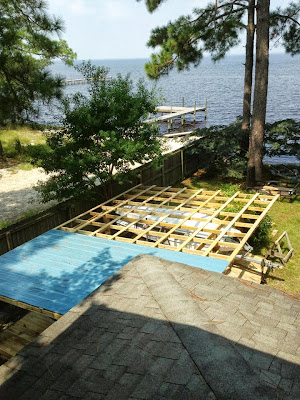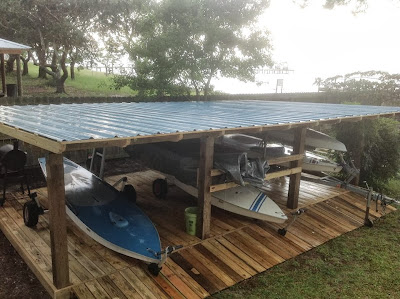We keep all of our 1980 Drascombe Lugger ONKAHYE's sailing gear in the boat when it is stored in the garage. Some items get moved to the van when taking off for a road trip. Today we rigged in the driveway and launched from the neighbor's ramp.
All our kids outgrew this life jacket so now it pulls duty as a road trip cushion for the main and mizzen, lashed down with one of the dock lines around the starboard stern cleat and traveler. We fly a couple of pennants, so now is the time to ship those to the top of the mast and mizzen.
The main is stowed in a side locker, the rudder rides on the cockpit sole, rudder is cushioned by an old towel.
Here is the rigging for the mainsheet on a MKII Lugger.
The bumpkin gets shipped through the transom, sheet is clipped to the sail and bitter end led through hole in transom to jam cleat. We leave it retracted in case we spin the boat around at the dock, that prevents it from getting snapped off. We also drop in an electric motor, used to maneuver to and from the dock if wind conditions are not conducive to sailing to and from. (Edit: We now use a 4 stroke Suzuki 6, longer run time, plenty of power, burns clean and runs quiet. The trolling motor was good for maneuvering around slips but not so good against current).
We use one of our throwable cushions to protect the mast for trailering. It is secured with the dock line around the belaying pins.
We placed a silver dime at the base of the mast as a gift to the wind gods.
When I rig the boat single handed, I step the mizzen first to get it out of the way and then step the mast. You have to raise the gaff a little and make sure all the parall beads and rigging clear the thwart. Once the mast is up, I lash the base around the belaying pins with a sail tie to hold it in place while I secure the jib.
The jib connects to the furling drum, it is a job that requires 2 1/2 hands. The easy way is one person pushing the mast forward a little and holding out the jib while a second person pins the shackle into the furling drum. The cotter pin also has a retaining clip.
The side stays are secured by taking a few turns through the fairleads in the cockpit and then throwing on a few half hitches.
Check out Skipper's Guide to Small Boat Knots!
Once the main mast is secure we like to raise the main without it being sheeted and get the halyard and downhaul sorted out. Then we lower the main, clip the clew to the sheet and stow it on the cockpit sole on the side farthest away from the dock. That way when we step in the boat from the dock we are not stepping on the sail.
ONKAHYE rigged and ready for the ramp.
Don't forget the drain plug! Dropped the boat in, Skipper also handles Dock Wench duties, she keeps the boat calm while I get the trailer out of the water.
Once in the water in the dock, we drop a little centerboard, put the motor down and ship the bumpkin. We motor out a bit and drop in the rudder, raise the sails and go for a cruise.
(Edit: We now have a wooden rudder rest that holds the rudder up).
ONKAHYE and CYANE taking a break.
Log of ONKAHYE.

























































